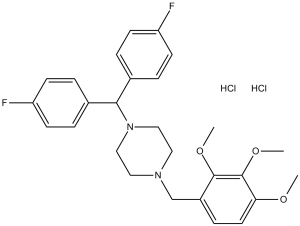Lomerizine HCl (KB-2796)
This product is for research use only, not for human use. We do not sell to patients.

For small sizes, please check our retail website as below: www.invivochem.com
| Size | Price | Stock |
|---|---|---|
| 1g | $450 | Check With Us |
| 2g | $650 | Check With Us |
| 5g | $980 | Check With Us |
Cat #: V1277 CAS #: 101477-54-7 Purity ≥ 98%
Description: Lomerizine HCl (KB-2796; Migsis; KB2796; KB 2796), the dihydrochloride salt of Lomerizine, is a diphenylpiperazine-based, relatively new and potent L- and T-type CCB/calcium channel blocker used for the treatment of migraine.
Top Publications Citing Invivochem Products
Publications Citing InvivoChem Products
Product Promise

- Physicochemical and Storage Information
- Protocol
- Related Biological Data
- Stock Solution Preparation
- Quality Control Documentation
| Molecular Weight (MW) | 541.46 |
|---|---|
| Molecular Formula | C27H30F2N2O3.2HCl |
| CAS No. | 101477-54-7 |
| Storage | -20℃ for 3 years in powder formr |
| -80℃ for 2 years in solvent | |
| Solubility In Vitro | DMSO: 100 mg/mL (184.7 mM)r |
| Water: <1 mg/mLr | |
| Ethanol: 52 mg/mL warmed (96.0 mM) | |
| Solubility In Vivo | 2% DMSO+ddH2O: 5mg/mL |
| Synonyms | KB-2796; Migsis; KB2796; KB 2796 |
| Protocol | In Vivo | To determine whether Ca2+ signaling molecules mediate NMDA-induced neurotoxicity in p50-deficient mice, the neuroprotective effects of chemical reagents are examined, which act on the Ca2+-signaling pathway including CaN activation, on NMDA-induced RGC death. The p50-deficient mice at 2 months of age, showing normal RGC survival, undergo intraperitoneal pretreatments with a NMDA antagonist, MK801 or Memantine; calcium blocker, Lomerizine; and CaN inhibitor, Tacrolimus, daily for 1 week before the injection of 5 nM NMDA. The chronic administration of Lomerizine or Tacrolimus to KO mice for 6 months results in an increase in surviving RGC numbers (p<0.0001) |
|---|
These protocols are for reference only. InvivoChem does not
independently validate these methods.
| Solvent volume to be added | Mass (the weight of a compound) | |||
|---|---|---|---|---|
| Mother liquor concentration | 1mg | 5mg | 10mg | 20mg |
| 1mM | 1.8469 mL | 9.2343 mL | 18.4686 mL | 36.9372 mL |
| 5mM | 0.3694 mL | 1.8469 mL | 3.6937 mL | 7.3874 mL |
| 10mM | 0.1847 mL | 0.9234 mL | 1.8469 mL | 3.6937 mL |
| 20mM | 0.0923 mL | 0.4617 mL | 0.9234 mL | 1.8469 mL |
The molarity calculator equation
Mass(g) = Concentration(mol/L) × Volume(L) × Molecular Weight(g/mol)
Mass
=
Concentration
×
Volume
×
Molecular Weight*
The dilution calculator equation
Concentration(start)
×
Volume(start)
=
Concentration(final)
×
Volume(final)
This equation is commonly abbreviated as: C1 V1 = C2 V2
Concentration(start)
C1
×
Volume(start)
V1
=
Concentration(final)
C2
×
Volume(final)
V2
Step One: Enter information below
Dosage mg/kg
Average weight of animals g
Dosing volume per animal µL
Number of animals
Step Two: Enter the in vivo formulation
%DMSO
+
%
+
%Tween 80
+
%ddH2O
Calculation Results:
Working concentration:
mg/ml;
Method for preparing DMSO master liquid:
mg
drug pre-dissolved in
µL
DMSO(Master liquid concentration
mg/mL)
,Please contact us first if the concentration exceeds the DMSO solubility of the batch of drug.
Method for preparing in vivo formulation:
Take
µL
DMSO master liquid, next add
µL
PEG300, mix and clarify, next add
µL
Tween 80,mix and clarify, next add
µL
ddH2O,mix and clarify.
Note:
- (1) Please be sure that the solution is clear before the addition of next solvent. Dissolution methods like vortex, ultrasound or warming and heat may be used to aid dissolving.
- (2) Be sure to add the solvent(s) in order.




































